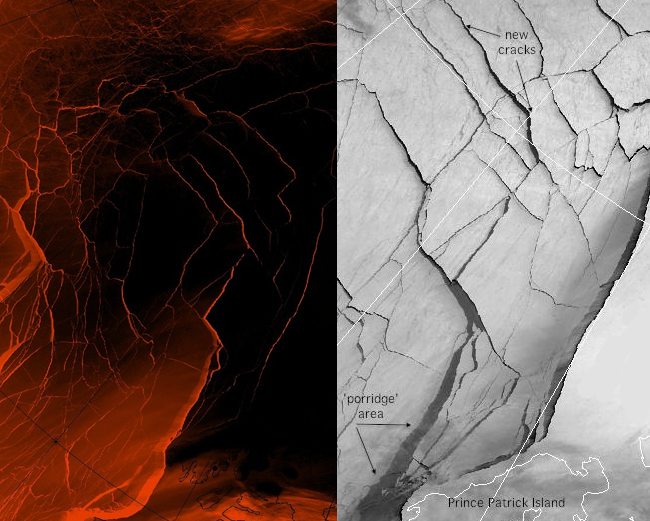Ice, Ice, Baby!
Greetings
Here is an interesting interview with Prof Peter Wadhams, and expert on sea ice, and a review editor for the IPPC. He discusses the problems with the current models, and some of limits to the IPCC process. He discusses the likely end of summer ice, the impact of methane and the likelihood of Southern Europe turning in to a desert in this century!
He is somewhat critical of government policy offices for their reliance of the models, and apparent ignoring the actual observations.
Just discovered Nevin's Sea Ice Blog. Quite Amazing. Lot's of video Interviews with sea ice scientists. Really good stuff.
Dr Jennifer Francis's article in Yale 360 linking weird weather with the changes in jet stream, caused by the warming in the Arctic.
Her article in Oceanography linking Super Storm Sandy to the Arctic, and the jet stream
Jeff Masters's blog about the jet stream and the odd spring weather - second most extreme March.
Death Spiral Video Help it go viral
The Dark Snow Project a crowd funded research project to find out how much does wildfire, and industrial soot contribute to Greenland melting
See also: Paul Bekwith,s blog:
UPDATE: NEW NASA SATELLITE IMAGERY
By Paul Beckwith
The Arctic region of our planet acts as a climatic air conditioner, and the air conditioner is conking out. We have a problem Houston.
Over the past few weeks, massive cracks have appeared in the ice that connects the Beaufort Gyre region to Alaska. As a result of last summer’s record sea ice-loss, the winter ‘refreezing’ process went dismally and the surface area and thickness never recovered. The situation is frightening with the beginning of the 2013 melt season only a few weeks away.
 Policymakers and governments around the world are still using outdated climate models and are therefore operating under faulty presumptions. The best example of this is their maintaining that the Arctic will retain sea ice until sometime between 2040 and 2070, ignoring the devastating 2012 summer loss of sea ice (roughly 30%!). For the record, they’re wrong - completely wrong! Six to 30 months is a much more likely scenario. Maintaining this naïve assumption will not only go down in history as colossal climatology #FAIL, it’s dangerous as it lulls people into a false sense of security (and atmosphere of non-urgency). It facilitates non-action, plain and simple. And we need action now.
Policymakers and governments around the world are still using outdated climate models and are therefore operating under faulty presumptions. The best example of this is their maintaining that the Arctic will retain sea ice until sometime between 2040 and 2070, ignoring the devastating 2012 summer loss of sea ice (roughly 30%!). For the record, they’re wrong - completely wrong! Six to 30 months is a much more likely scenario. Maintaining this naïve assumption will not only go down in history as colossal climatology #FAIL, it’s dangerous as it lulls people into a false sense of security (and atmosphere of non-urgency). It facilitates non-action, plain and simple. And we need action now.HANG ON FOLKS
What does this mean for the planet? If you’ve followed my previous blogs over the past year, you know that as the sea ice and snow cover declines, strange things start happening to jet streams. Very strange. They slow down, become much wavier and more unpredictable (like Frankenstorm Sandy taking a left instead of right), and are directly responsible for an increase in the frequency, size and severity of extreme weather events (floods, heat waves, droughts, etc.). Climate refugees, global disruption of agriculture, growingly-extreme weather events and phenomena… unless we act soon the future is certainly grim.
As is usual these days, the best and most accurate up-to-date information on the state of Arctic sea ice is obtained from climatology blogs and a wealth of online data sources (if you want to look for it, that is). Uncensored near-real-time data and images of sea ice thickness, concentration, motion, temperature and just about anything else you can measure can be found here and here. For example, here's the movie showing how the sea ice thickness has decreased over the past year. The state of deterioration is clear (and shocking).
So back to those new Arctic icecap cracks developing… everything you need to know can be found here. Even better than the images and the article itself, in my opinion, are the comments from climatologists, scientists and a growing number of very informed amateurs from around the world. These folks are very knowledgeable about Artic sea ice; many of them have followed the disappearing Artic sea ice for years and are clearly a step ahead of most scientists in their field (at least those scientists not following the links above!). It’s these folks who first spotted the cracking and raced to archival satellite imagery (from 2012) to confirm their fears. Turns out those cracks are appearing 51 days earlier than they did last year. That’s a staggering revelation and a game-changer (NOT a good one) as we approach the 2013 melt season.
As I wrote before: Hold on folks… the times they are a-changin’.
Paul Beckwith is a PhD student with the laboratory for paleoclimatology and climatology, department of geography, University of Ottawa.
Labels: climate sea ice, Dark Snow Project, Glacier, Jeff Masters, Jennifer Francis

0 Comments:
Post a Comment
Subscribe to Post Comments [Atom]
<< Home